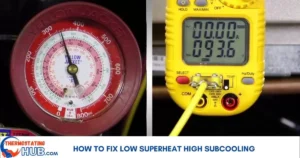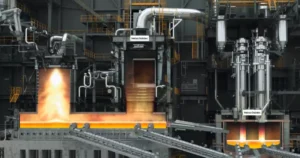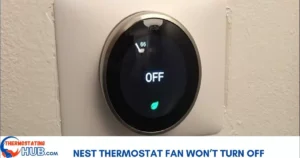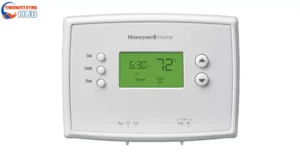If your furnace keeps shutting off just 30 seconds after firing up, chances are it’s because of a dirty or faulty flame sensor. This crucial component in your furnace serves as a safety measure, protecting you from potential gas leaks.
The flame sensor’s job is to promptly cut off the furnace if it can’t detect flames within a minute.
Now, let’s delve into additional reasons behind this issue and explore the steps you can take to troubleshoot and resolve it. 🔧
Reasons a furnace would shut off after 30 minutes of starting
| Possible Cause | Solution |
| Dirty flame sensor | Clean or replace the flame sensor |
| Faulty flame sensor | Swap out the flame sensor |
| Clogged Air Filter | Install a new filter |
| Blower motor/Capacitor issues | Replace the blower motor capacitor |
| Malfunctioning furnace control board | Get a new furnace control board |
| Defective thermostat | Upgrade to a new thermostat |
Encountering a furnace shutdown issue can be frustrating, but identifying and addressing the root cause is key to restoring proper functionality. If your furnace is acting up, follow these suggested fixes to keep your home warm and cozy. 🔥
Dirty flame sensor
As previously mentioned, the flame sensor acts as a safety device, automatically shutting off the gas valve if it fails to detect flames approximately 30 seconds after the furnace ignites, indicating a scenario of the furnace igniting but no flame present.
Over time, the flame sensor can accumulate dirt or residue from the combustion of flames. This residue buildup on the flame sensor hinders its ability to detect flames, even when the burners are functioning correctly and accurately.
Consequently, the dirty flame sensor may signal to the control board that no flame is present. In response, the control board promptly closes the gas valve, leading to the complete shutdown of the furnace. This interruption ensures your safety by preventing the continuation of gas flow without reliable flame detection. 🔥
Fix
If your flame sensor is dirty, a quick fix might be to clean it. Grab a paper bill, like a $1 bill, wrap it around the flame sensor, and give it a good rub. It’s a surprisingly effective method. Check out the video below for a demonstration of how to clean a flame sensor.
Using currency notes works remarkably well in clearing away the grime from the flame sensor, although the science behind it might remain a bit of a mystery. 💸
Read also: Furnace Ignitor Lights But No Flame [Fixed]
Bad flame sensor

If cleaning the flame sensor doesn’t resolve the short cycling issue, you may have a faulty flame sensor. Replacing the flame sensor might be necessary.
Flame sensors can be pricey, so before delving into other troubleshooting measures, consider giving a new flame sensor a try.
Typically, a flame sensor has a lifespan of around 5 years, while a furnace can last anywhere from 15 to 20 years. Therefore, anticipate replacing the flame sensor 2-3 times over the furnace’s lifetime. It’s a maintenance step that contributes to the overall longevity and efficient performance of your heating system. 💡
Dirty Filter
If your furnace is cutting out just 30 seconds after firing up, it could be pointing to a dirty furnace air filter. When was the last time you swapped out your air filter?
If it’s been over 2 months, it’s about time for a replacement.
Some air handlers and thermostats are equipped with filter replacement indicators. Yet, if you still need to get these or missed the replacement message, a quick check at the furnace is always a good idea.
Should you find a dirty furnace filter, an immediate replacement is needed to rectify the issue.
Just ensure you get the right model by checking your current filter’s specifications first. The location of your air filter might vary based on the furnace’s make and model. While, for many furnace models, it’s typically found near or inside the furnace compartment, refer to your manual for precise details on your specific model. 🔄
Defective blower motor / Capacitor
The blower motor is a crucial component in the overall functioning of a furnace.
Operating within the system, a furnace blower draws in air from the home through the return registers. Subsequently, it propels this air over the heat exchangers, where it’s heated and then distributed throughout the ductwork.
When the blower motor malfunctions, it hampers the circulation of hot air, leading to potential overheating issues.
An overheated furnace activates the high limit switch, resulting in the furnace shutting down shortly after starting. This protective mechanism ensures that the furnace doesn’t continue operating in a compromised state, prioritizing safety in your heating system. ⚙️
How to know if your blower motor is defective
To access the furnace blower, open the blower compartment, ensuring the furnace’s power is switched off.
Attempt to spin the blower wheel manually. Usually, if the blower motor is faulty, it won’t spin during this manual attempt. However, if it does spin manually but fails to operate during normal functions, you might be dealing with a weak or defective motor capacitor. This component could be affecting the motor’s ability to kick into action when needed.
Checking and potentially replacing the motor capacitor could be a step toward resolving the issue and getting your furnace back in working order.
How to know if your motor capacitor is defective:
- The capacitor plays a crucial role in storing the necessary energy for starting the blower motor. A weak capacitor, however, struggles to kickstart the blower motor.
- A telltale sign of a problematic capacitor is a humming sound emanating from the blower motor when the furnace is turned on.
- To confirm the issue lies with the capacitor, utilize a multimeter for a thorough diagnosis.
- The most effective resolution for a faulty capacitor is a straightforward replacement with a properly functioning one.
- It’s worth noting that if one component in the blower assembly fails, the likelihood of other components failing increases. Consequently, opting to replace the entire blower motor assembly is often the wisest course of action. 🔄
Bad furnace control board
If your furnace keeps shutting off every 30 seconds and nothing else seems to be the issue, the culprit might be a faulty furnace control board.
Think of the furnace control board as the brains of your heating system. It’s like the motherboard, processing all the instructions it gets from the thermostat.
If you have a hunch that your control board is acting up, consider a replacement. But hold on before jumping into it – it’s a good idea to get a second opinion from a local onsite technician just to be sure. 👨🔧
Dealing with furnace issues can be tricky, and sometimes, a second pair of expert eyes can provide valuable insights. A local technician can assess the situation accurately and guide you on whether a control board replacement is the right move. So, before committing to any changes, consult with a pro to ensure you’re on the right track to a cozy and warm home.
Bad thermostat
In some rare instances, the repeated shutdowns of your furnace might be traced back to a malfunctioning thermostat.
If you’ve recently installed a new thermostat and are experiencing issues, consider going back to your previous one and checking if the problem persists.
If the problem disappears when using the old thermostat, it could indicate that the new one is either defective or there’s an underlying problem with the thermostat wiring.
Exploring the functionality of your thermostat is a crucial step in troubleshooting furnace problems. Reverting to the old thermostat can help identify if the issue lies with the new installation or if there’s a deeper problem with the wiring. It’s like a detective game for your heating system – figuring out the clues to ensure your home stays warm and comfortable.
Exploring the Pros and Cons of Furnace Shutdowns After 30 Seconds

| Pros | Cons |
| 1. Energy Conservation: Brief run cycles save energy compared to extended operation. | 1. Inadequate Heating: Frequent shutdowns may result in insufficient heating, especially in colder climates. |
| 2. Reduced Wear and Tear: Shorter cycles can lead to less wear on the furnace components. | 2. Potential Component Stress: Frequent on-off cycles can stress certain furnace components, affecting their lifespan. |
| 3. Quick Response to Demand: The furnace quickly responds to temperature fluctuations, maintaining comfort. | 3. Energy Inefficiency: Frequent restarts can lead to energy inefficiency and increased utility costs. |
| 4. Improved Air Quality: Short cycles may contribute to better air filtration and quality. | 4. Thermostat Issues: Rapid cycling may indicate thermostat problems, requiring attention and potential replacement. |
While short furnace shutdowns after 30 seconds offer benefits such as energy conservation and reduced wear, there are drawbacks, including potential inadequate heating and stress on components. If you notice frequent short cycles, it’s advisable to consult with an HVAC professional (How To Find?) to diagnose and address any underlying issues for optimal furnace performance. 🔍
Unlocking Future Innovations in Addressing Furnace Shutdowns within 30 Seconds
Furnace shutdowns in a 30-second timeframe can be a hassle, but the future of heating systems is gearing up for a game-changer. Check out what’s on the horizon:
Smart Predictive Technology:
Picture this – future furnaces armed with clever predictive algorithms. These algorithms will be like heating mind-readers, foreseeing your warmth needs. Say goodbye to unnecessary shutdowns as they optimize performance using historical data and real-time conditions. 🌐
Variable Speed Technology:
Imagine furnaces with a knack for adjusting their operational speed on the fly. Thanks to innovations in variable speed technology, short cycles become a thing of the past. Now, you can expect a more consistent and efficient heating process. 🔄
Integrated System Intelligence:
The future looks bright with integrated systems using artificial intelligence. Furnaces that chat seamlessly with other HVAC buddies like thermostats and ventilation systems. It’s a teamwork approach to temperature regulation, minimizing those abrupt shutdowns.
Enhanced Component Durability:
Next-gen furnace designs may feature materials and tech that toughen up critical components. Less wear and tear from frequent cycling means a longer lifespan for your heating system. Now, that’s durability! 🔧
User-Friendly Diagnostics:
Ever wish you could decode your furnace’s language? Advanced diagnostics interfaces and user-friendly apps are in the works. Homeowners get the power to monitor and troubleshoot furnace performance, making short shutdown mysteries a breeze to solve. 🔍
Looking ahead, these innovations are like superheroes for home heating. They’re set to tackle the challenges of short furnace shutdowns, paving the way for heating solutions that are efficient, reliable, and user-friendly. 🚀
Unveiling Key Features to Prevent and Troubleshoot Furnace Shutdowns After 30 Seconds

Understanding and tackling furnace shutdowns within a 30-second timeframe is pivotal for top-notch performance. Let’s explore some standout features geared to prevent and troubleshoot these occurrences:
Smart Thermostats with Delay Functionality:
Ever heard of thermostats playing it smart? Those equipped with delay functionality take the lead. They put the brakes on rapid on-off cycles by introducing a brief pause before starting another heating cycle, slashing the frequency of short shutdowns. 🕐
Variable Speed Blower Motors:
Picture this – furnaces armed with variable speed blower motors. These motors offer a handle on airflow, ensuring a gradual and efficient heat distribution. The result? A minimized chance of rapid shutdowns and a toastier, evenly heated space.
Advanced Temperature Sensors:
Precision is the name of the game. Furnaces with advanced temperature sensors up their game by accurately gauging home temperatures. This accuracy means no more unnecessary shutdowns; the furnace kicks into action only when it’s genuinely needed.
Diagnostic Systems with Error Code Displays:
Enter the superheroes of furnaces – those with advanced diagnostic systems and error code displays. Homeowners and technicians unite! This dynamic duo identifies issues pronto, paving the way for swift troubleshooting and resolution of problems causing short shutdowns.
Adaptive Control Algorithms:
Fast forward to the future – meet furnace models with adaptive control algorithms. These brainy algorithms are in a continuous learning loop, tweaking operational parameters on the fly. The result? Furnaces that anticipate heating needs put a damper on short shutdowns. 🚀
By weaving these features into the fabric of home heating, homeowners wield proactive power. Say goodbye to short-lived shutdowns and hello to a heating system that’s both reliable and efficient. And, of course, remember the regular maintenance check-ups and chats with HVAC professionals to keep everything running smoothly. 🔧
Answers To Key Questions
Why does my furnace run for 30 seconds then shut off?
This could be due to a variety of issues, such as a clogged air filter, a malfunctioning flame sensor, or problems with the gas supply. Professional inspection is recommended for accurate diagnosis and resolution.
Why does my furnace run for 45 seconds then shut off?
Potential causes include issues with the thermostat, a malfunctioning limit switch, or problems with the ignition system. Professional assessment is advised to identify and address the specific problem.
Why does my furnace only turn on for a few seconds?
This may be indicative of a faulty flame sensor, a clogged air filter, or problems with the gas supply. A professional inspection is recommended to determine the root cause and carry out necessary repairs.
Why does my furnace only run for a minute?
Possible reasons include a malfunctioning thermostat, issues with the flame sensor, or problems with the ignition system. Professional evaluation is advisable to pinpoint the specific problem and implement appropriate solutions.
Final Thoughts
Addressing a furnace that consistently turns off after only 30 seconds is vital for maintaining a warm and cozy home. 🏡
The main culprit for this issue often lies in a dirty or faulty flame sensor, a safety feature designed to prevent potential gas leaks.
To troubleshoot and fix the problem, it’s essential to grasp the key components and potential causes, such as a clogged air filter, a malfunctioning blower motor, or a defective thermostat.
Regular maintenance and swift attention to issues contribute significantly to the longevity and efficiency of your heating system. Whether it involves a quick clean of the flame sensor or a more substantial component replacement, following these steps ensures your furnace operates smoothly, keeping you comfortable during chilly days. Stay warm! 🔥

I’m Matthew Porter, the HVAC enthusiast at thermostatinghub.com. Beyond being a writer, I’m your dedicated problem solver for all things heating and cooling. Join me on my blog for a storytelling adventure through the HVAC universe. Together, let’s transform your comfort challenges into tales of coziness!
![Furnace Shuts Off After 30 Seconds [Fixed]](https://thermostatinghub.com/wp-content/uploads/2023/12/furnace-shuts-off-after-30-seconds.webp)













